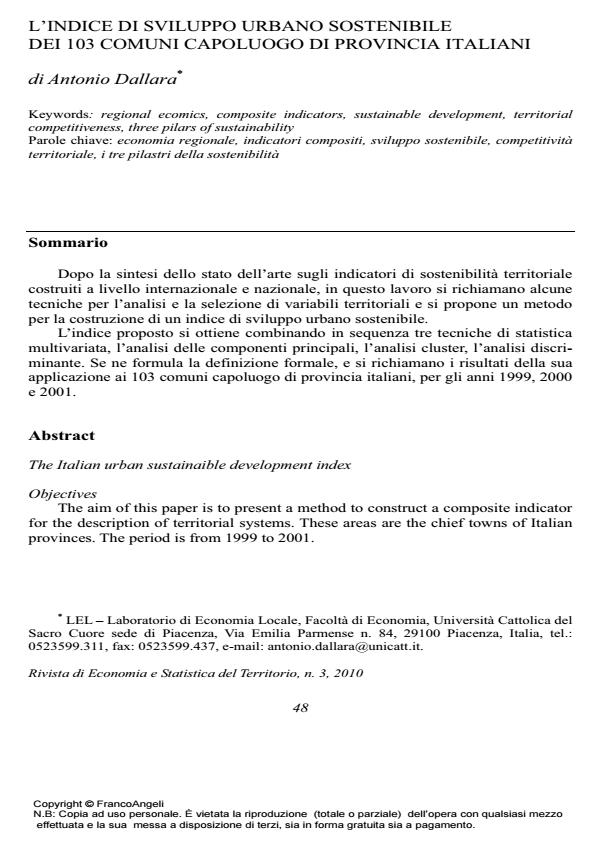L'indice di sviluppo urbano sostenibile dei 103 comuni capoluogo di provincia italiani
Journal title RIVISTA DI ECONOMIA E STATISTICA DEL TERRITORIO
Author/s Antonio Dallara
Publishing Year 2010 Issue 2010/3
Language Italian Pages 32 P. 48-79 File size 392 KB
DOI 10.3280/REST2010-003003
DOI is like a bar code for intellectual property: to have more infomation
click here
Below, you can see the article first page
If you want to buy this article in PDF format, you can do it, following the instructions to buy download credits

FrancoAngeli is member of Publishers International Linking Association, Inc (PILA), a not-for-profit association which run the CrossRef service enabling links to and from online scholarly content.
The Italian urban sustainaible development index Objectives The aim of this paper is to present a method to construct a composite indicator for the description of territorial systems. These areas are the chief towns of Italian provinces. The period is from 1999 to 2001. Methods and Results The methodology is based on three statistical multivariate techniques: principal component analysis (PCA), cluster analysis (CA), discriminant analysis (DA). These techniques are applied in consecutive way, one after another. The output of PCA is the input of CA, and the output of CA is the input of DA. PCA enables the selection of elementary variables, and constructs three macro-variables syntheses. CA separates territorial systems in two groups. DA defines a linear relation among the variables used in the previous CA, and DA defines sorting of territories. The composite indicator presents a good statistical robustness, the tests are significant and the results are consistent in economic terms. Over the time the relative positions of chief towns doesn’t undergo strong variations. They just had small dynamics for conjunctural events. The analyzed period of time is too short to bring out big structural changes. In these three years we note the typical dualism of the economic development of Italian territories. But there is a new element: the same dualism is also in social and environmental dimensions. Each elementary variable of society and environment usually explains this dichotomy. The proposed composite indicator emphasizes this characteristic of the development and growth Italian model. After Bolzano, Milan and Trieste, at the top of ranking we find small-medium towns of Northern and Centre Italy, and the medium-large towns of Central Italy. The development trajectories of medium towns of North and Central enables to combine simultaneously economic growth, social equity and cohesion, environmental quality. It is better in the Northern than in the Southern towns. Conclusions Metropolitan areas of North-Centre are in the first positions of ranking (Milan 2nd, Florence 4th, Bologna 6th, Rome 12th). Metropolitan areas of South are far back in the ranking: Palermo 93rd, Bari 87th, and before Catania 78th and Naples 79th. Cities in rural territorial systems of North and Centre are middle-ranking. And they are together with medium cities of industrial context. Southern towns of rural systems often precede metropolitan areas. If we focus on Southern Italy, the weaknesses of towns appear evident: Foggia (69th) is the first in 2001 in Mezzogiorno towns. But the South has its specificities. Sardinia’s towns are near to towns of Campania and of Sicily. Big towns of the Mezzogiorno don’t able to emerge from the rest of Southern Italy. It is very different in the North, where Milan and Bologna push the integrated development of their territories.
Jel codes: R1, R100
Antonio Dallara, L'indice di sviluppo urbano sostenibile dei 103 comuni capoluogo di provincia italiani in "RIVISTA DI ECONOMIA E STATISTICA DEL TERRITORIO" 3/2010, pp 48-79, DOI: 10.3280/REST2010-003003